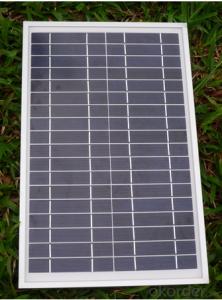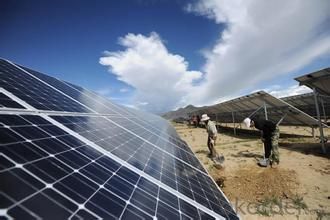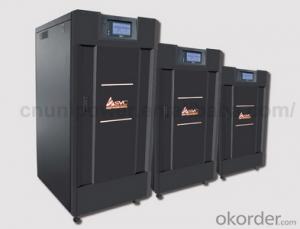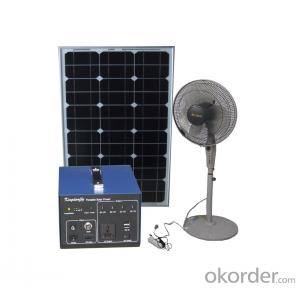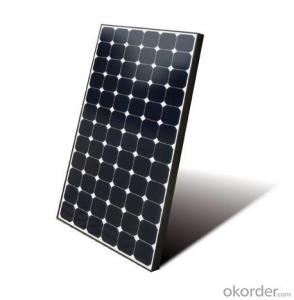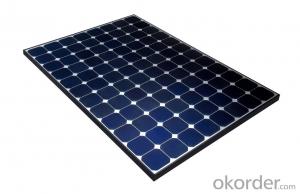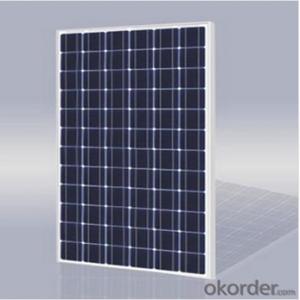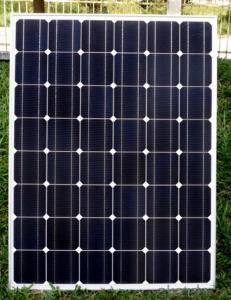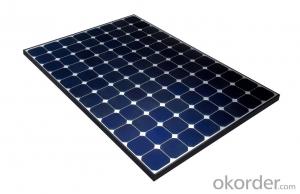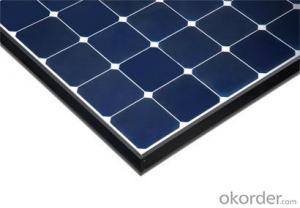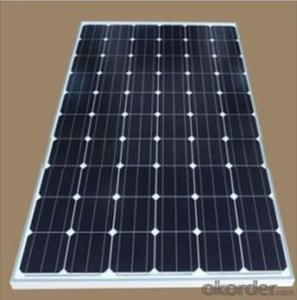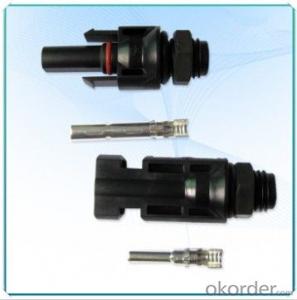300kw CNBM Monocrystalline Silicon Solar Energy Systems Panel for Home Use in Anaheim, CA
- Loading Port:
- Shekou
- Payment Terms:
- TT OR LC
- Min Order Qty:
- 100 watt
- Supply Capability:
- 1000 watt/month
OKorder Service Pledge
OKorder Financial Service
You Might Also Like
Specification
300KW CNBM Monocrystalline Silicon Panel for Home Using
Production description
Solar power is the conversion of sunlight into electricity, either directly using photovoltaics (PV), or indirectly using concentrated solar power (CSP). Concentrated solar power systems use lenses or mirrors and tracking systems to focus a large area of sunlight into a small beam. Photovoltaics convert light into anelectric current using the photovoltaic effect.[1]
Solar energy is radiant light and heat from the Sun harnessed using a range of ever-evolving technologies such assolar heating, photovoltaics, solar thermal energy, solar architecture and artificial photosynthesis.
It is an important source of renewable energy and its technologies are broadly characterized as either passive solar oractive solar depending on the way they capture and distribute solar energy or convert it into solar power. Active solar techniques include the use of photovoltaic systems,
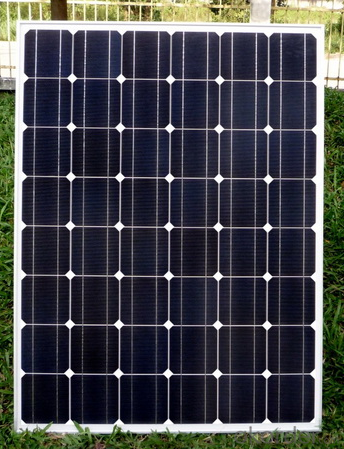
Feature
1.High conversion efficiencies resulting in superior power output performance.
2.Outstanding power output even in low light or high temperature conditions
3.Optimized design for ease of soldering and lamination
Physical characteristic
1. Rigorous quality control meets the highest international standards.
2. High-transmissivity low-iron tempered glass, strong aluminium frame.
3. Using UV-resistant silicon.
4. IS09001/14001/CE/TUV/UL
packaging
26pcs in one carton 6pallets in 20foot container 14pallets in 40 foot container.
- Q: Can solar energy systems be used in mining operations?
- Yes, solar energy systems can be used in mining operations. Solar power can provide a sustainable and reliable source of electricity for various mining activities, such as powering equipment, lighting, ventilation, and processing plants. It reduces dependence on traditional fossil fuel-based energy sources, lowers operational costs, and minimizes environmental impacts. However, the feasibility and effectiveness of solar energy systems in mining operations depend on factors like location, energy demands, and technical considerations.
- Q: Can solar energy systems be used in powering schools or educational institutions?
- Certainly, solar energy systems are a viable option for powering schools and educational institutions. By installing solar panels on the rooftops of these establishments, they can generate electricity that is both clean and renewable. This reduces their dependence on traditional fossil fuels, resulting in numerous advantages. Not only does it decrease greenhouse gas emissions and combat climate change, but it also leads to long-term cost savings on energy bills. Additionally, educational institutions have the opportunity to set an example for sustainable practices by employing solar energy and educating students about the significance of renewable power sources. Furthermore, solar power systems can be incorporated into the curriculum, allowing students to gain practical knowledge about solar energy and its real-world applications. All in all, integrating solar energy systems into schools and educational institutions presents a multitude of benefits, including environmental sustainability and educational opportunities.
- Q: Can a solar energy system be installed on a hospital or healthcare facility?
- Yes, a solar energy system can be installed on a hospital or healthcare facility. In fact, many hospitals and healthcare facilities around the world have already implemented solar energy systems as a way to reduce their carbon footprint and lower their energy costs. Solar panels can be installed on the rooftop of the facility or in an adjacent open space, depending on the available area. These systems can generate electricity from sunlight, which can be used to power various operations within the hospital, including lighting, heating, and cooling systems, as well as medical equipment. The use of solar energy not only helps the facility save on energy costs but also promotes sustainability and environmental responsibility. Additionally, solar energy systems can provide a reliable and independent source of power, which can be crucial during emergencies or power outages, ensuring uninterrupted healthcare services.
- Q: What is the role of solar energy systems in reducing greenhouse gas emissions?
- Solar energy systems play a crucial role in reducing greenhouse gas emissions by harnessing the power of the sun to generate electricity without releasing any harmful pollutants or greenhouse gases into the environment. These systems provide a clean and renewable alternative to fossil fuel-based energy sources, such as coal or natural gas, which are major contributors to greenhouse gas emissions. By utilizing solar energy, we can significantly decrease our reliance on fossil fuels and mitigate the impact of climate change by reducing carbon dioxide and other greenhouse gas emissions.
- Q: Can solar energy systems be used for powering data centers?
- Yes, solar energy systems can be used for powering data centers. Solar panels can be installed on the rooftops or in the vicinity of data centers to generate electricity from sunlight. This renewable energy source can help data centers reduce their reliance on traditional power grids, lower their carbon footprint, and potentially save costs in the long run.
- Q: How does the quality of solar panels affect their performance?
- The quality of solar panels directly affects their performance. Higher quality panels tend to have better conversion efficiency, meaning they can convert a higher percentage of sunlight into electricity. They also tend to be more durable and have a longer lifespan, which means they can continue to generate electricity efficiently over a longer period of time. In contrast, lower quality panels may have lower efficiency, degrade faster, and be more prone to failure, resulting in reduced performance and shorter lifespans. Therefore, investing in higher quality solar panels is crucial for maximizing their performance and long-term benefits.
- Q: Can a solar energy system power an entire home?
- Yes, a solar energy system can power an entire home. With advancements in solar technology, it is now possible to generate enough electricity from solar panels to meet the energy needs of a typical household. A solar energy system consists of solar panels that convert sunlight into electricity, an inverter that converts the DC electricity generated by the panels into AC electricity for use in the home, and a battery storage system to store excess energy for use during cloudy or low sunlight periods. The size and capacity of the solar energy system will depend on the energy requirements of the home. Factors such as the number of occupants, energy consumption patterns, and the availability of sunlight in the area will determine the number of solar panels needed. It is essential to conduct a thorough energy audit to determine the appropriate system size. By installing a solar energy system, homeowners can significantly reduce or eliminate their dependence on the traditional electrical grid. In some cases, excess electricity generated by the system can be sold back to the grid, leading to potential cost savings. Additionally, solar energy is a clean and renewable source of power, reducing carbon emissions and benefiting the environment. However, it is important to note that the efficiency and effectiveness of a solar energy system can be influenced by various factors such as the location and orientation of the panels, the amount of sunlight available, and the weather conditions. Therefore, it is advisable to consult with a professional solar installer to design and install a system that meets the specific needs of the home.
- Q: What is the average lifespan of a solar energy system?
- The average lifespan of a solar energy system is typically around 25-30 years.
- Q: Can solar energy systems be used in powering fire stations or police stations?
- Yes, solar energy systems can be used to power fire stations or police stations. Solar energy is a renewable and sustainable source of power that can provide a reliable and cost-effective solution for these facilities. Fire stations and police stations typically require a consistent and uninterrupted power supply for lighting, communications, security systems, and other essential equipment. Solar panels can be installed on the rooftops or in nearby areas to harness sunlight and convert it into electricity. This electricity can then be used to power the various electrical systems within these facilities. By using solar energy, fire stations and police stations can reduce their reliance on traditional grid electricity, lower their operational costs, and contribute to a greener environment. Additionally, solar energy systems can also include battery storage to store excess electricity generated during the day, ensuring a continuous power supply even during nighttime or periods of low sunlight. Overall, solar energy systems are a viable and practical option for powering fire stations and police stations, promoting energy independence and sustainability for these crucial public service institutions.
- Q: What is the impact of roof angle on the performance of solar panels?
- The angle of a roof has a significant impact on the performance of solar panels. The ideal roof angle depends on the geographical location of the installation and the time of year. In general, solar panels perform best when they are tilted at an angle that allows them to capture the maximum amount of sunlight throughout the day. This is because the angle affects the amount of direct sunlight that falls on the panels, which directly impacts their energy production. In regions closer to the equator, where the sun is more directly overhead, a roof angle of around 30 to 45 degrees is typically recommended. This allows the panels to receive the maximum amount of sunlight during the year. On the other hand, in regions farther from the equator, where the sun is lower in the sky, a steeper roof angle of around 45 to 60 degrees may be more suitable to optimize solar panel performance. The impact of the roof angle on solar panel performance is also noticeable during different seasons. For example, in the summer when the sun is higher in the sky, a flatter roof angle may be more effective in capturing sunlight. Conversely, during the winter when the sun is lower, a steeper roof angle can help maximize energy production. It is important to note that while the roof angle is a crucial factor, other factors such as the orientation of the panels (facing south is usually preferred in the Northern Hemisphere) and shading from nearby objects or trees can also influence the performance of solar panels. Proper planning and design are essential to ensure optimal performance and efficiency of the solar panel system.
Send your message to us
300kw CNBM Monocrystalline Silicon Solar Energy Systems Panel for Home Use in Anaheim, CA
- Loading Port:
- Shekou
- Payment Terms:
- TT OR LC
- Min Order Qty:
- 100 watt
- Supply Capability:
- 1000 watt/month
OKorder Service Pledge
OKorder Financial Service
Similar products
Hot products
Hot Searches
Related keywords
